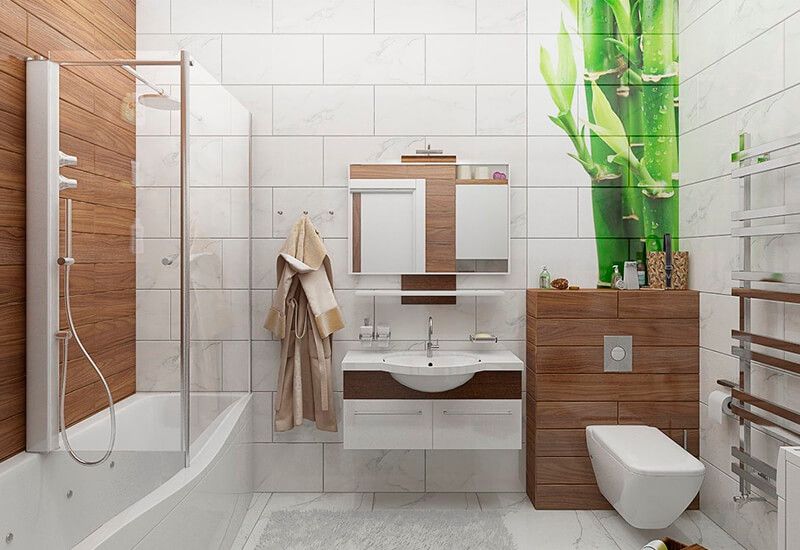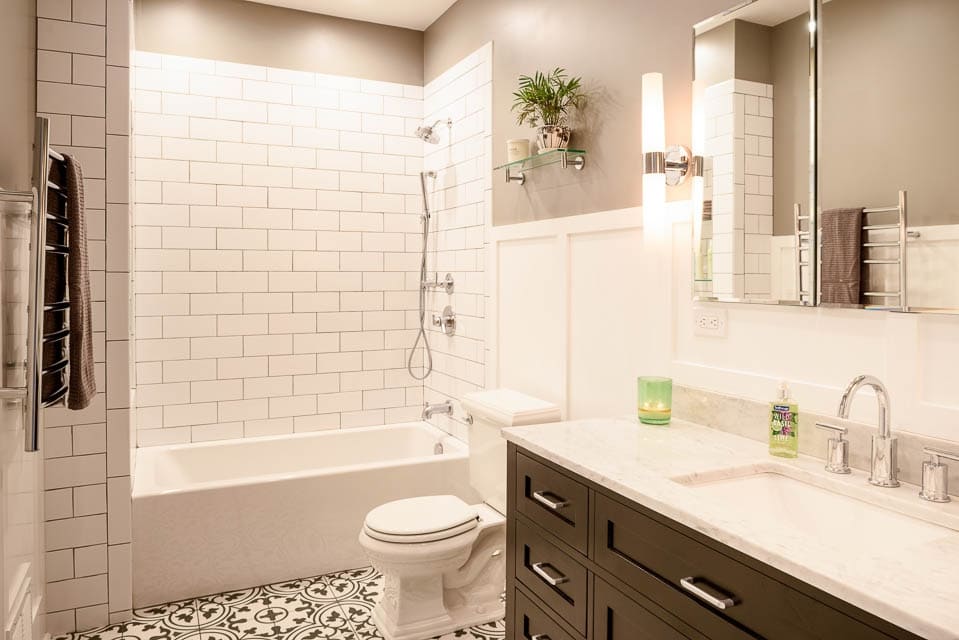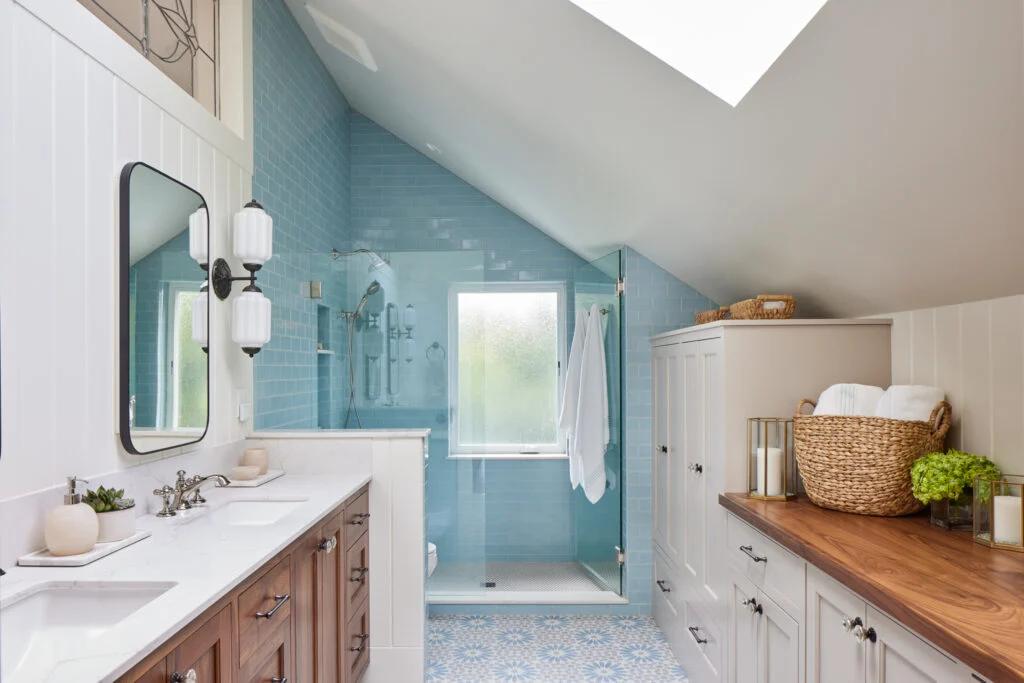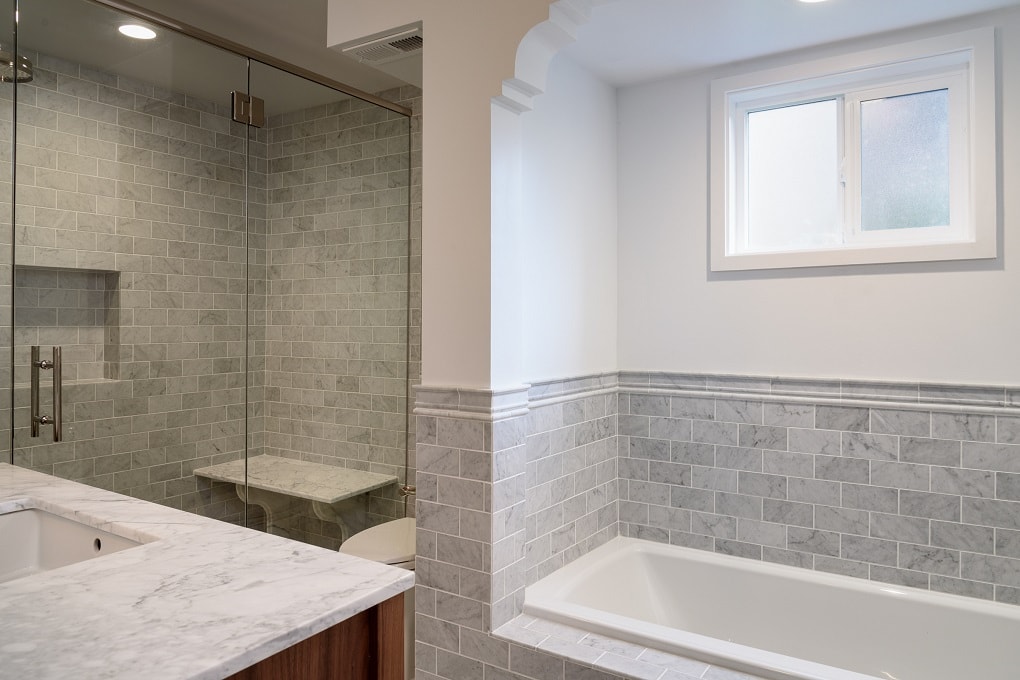Transform Your Bathing Experience with a Freestanding Tub
Bathing should be a relaxing experience, not just a routine. A freestanding tub can turn your bathroom into a luxurious sanctuary. At Guarantee Quality Construction LLC, we specialize in installing stunning freestanding tubs in Seattle and surrounding areas. Whether you prefer modern or classic styles, our team will help you select and install the perfect tub to elevate your space and provide a rejuvenating bathing experience.
What is a Freestanding Tub?
A freestanding tub, as the name suggests, stands alone without the need for surrounding walls. Unlike traditional built-in tubs, which are typically enclosed on three sides, a freestanding tub offers more freedom in placement, allowing you to position it anywhere in your bathroom and create a more open, versatile space.

Types of Freestanding Tubs
- Total projectThere’s a wide variety of freestanding tubs, each offering its own unique style and feel:
- Clawfoot Tubs: These timeless tubs have remained a favorite due to their classic charm. With ornate sculpted feet, they elevate the tub and add a touch of vintage elegance.
- Slipper Tubs: Featuring one or both ends raised for optimal back and head support, slipper tubs provide a luxurious and comfortable bathing experience.
- Pedestal Tubs: Unlike clawfoot tubs with multiple feet, pedestal tubs rest on a single, elegant base, giving them a streamlined and modern appearance.
- Japanese Soaking Tubs: Compact yet deep, these tubs are designed for vertical soaking, making them perfect for smaller bathrooms while offering a relaxing, immersive experience.
Styling Your Bathroom with a Freestanding Tub
A freestanding tub is a stunning focal point that can instantly enhance your bathroom’s design. Here are a few styling ideas:
- Add Drama: Make a statement with a bold-colored tub as the centerpiece of a monochromatic bathroom, or spice things up with patterned tiles and luxurious lighting.
- Go Minimalistic: Choose a tub with sleek, clean lines for a modern and sophisticated look. Pair it with a neutral color scheme to create a calming, Zen-inspired space.
- Create a Classic Look: For a vintage-inspired feel, opt for a clawfoot or slipper tub. Add elegant gold or bronze fixtures to complete the timeless aesthetic.
Material Options for Freestanding Tubs
Freestanding tubs come in a variety of materials, each offering distinct advantages:
- Acrylic: Lightweight and high-gloss, acrylic is a popular choice for its flexibility in design, resistance to scratches, and excellent heat retention.
- Stone Resin: A combination of natural stone and resin, this material creates a solid and durable tub that maintains water temperature effectively.
- Cast Iron: Known for its durability and resistance to chips and scratches, cast iron tubs keep water warm for longer. However, they are the heaviest option.
- Fiberglass: A cost-effective, lightweight option, fiberglass requires regular upkeep to avoid cracking or color fading.
TIP: The right material for your tub depends on your budget, desired maintenance level, and aesthetic preferences.

How to Choose the Perfect Freestanding Tub
To make sure your freestanding tub becomes a beloved part of your home, keep these key factors in mind:
- Features: While basic tubs simply hold water, some models offer additional features like hydrotherapy jets, spill-proof edges, and self-cleaning systems.
- Size: Measure your bathroom space to determine the ideal tub dimensions. Consider who will use it and choose the right depth for comfort.
- Style: Choose a design that complements your bathroom’s overall aesthetic, whether modern, vintage, or somewhere in between.
- Material: Think about the level of maintenance you’re comfortable with and your budget to select the right material.
Frequently Asked Questions about Freestanding Tubs
Are freestanding tubs comfortable?
Comfort is subjective and varies from person to person. However, freestanding tubs are typically admired for their spacious and deep design. These tubs encourage relaxation by allowing you to fully submerge and unwind. To ensure the perfect fit, it’s important to check the tub’s dimensions and make sure it offers the depth and length that suits your comfort needs.
Can a Freestanding Tub be Moved?
While freestanding tubs aren’t designed for frequent relocation, they can be moved if needed. This offers great flexibility when you’re redesigning or rearranging your bathroom. Keep in mind, though, that moving the tub will also require reinstallation of the plumbing to accommodate its new position.
Before painting, the home’s exterior may need cleaning, repairs, or priming. If your siding has peeling paint, cracks, or mildew, additional prep work will be required, adding to the overall cost.
How Much Space Does a Freestanding Tub Require?
The amount of space a freestanding tub needs depends on its size, but generally, it requires a fair amount of room. In addition to the tub’s dimensions, you’ll need sufficient space for easy entry and exit. Be sure to factor in these considerations when planning your bathroom layout.
What is the Weight of a Freestanding Tub?
The weight of a freestanding tub depends on its size, material, and whether it’s a water or air jetted model. On average, a freestanding tub weighs between 100 to 200 pounds when empty. However, once filled with water, the weight can increase significantly. This is an important factor to consider, especially when installing the tub on upper floors.

Can a Freestanding Tub Be Used in a Bathroom Remodel?
Yes, a freestanding tub can be a beautiful addition to a bathroom remodel, as long as there’s enough space for it. It can serve as a focal point, creating a luxurious, spa-like atmosphere. Careful planning of the layout is essential since the tub will need both water supply and drain connections.
How Are Freestanding Tubs Cleaned?
Freestanding tubs can be cleaned with mild detergents or non-abrasive cleaners and warm water. Avoid abrasive cleaning products, as they can scratch and damage the surface. For tougher stains, a mixture of vinegar and baking soda can be very effective. Regular cleaning helps maintain the tub’s finish.
How Long Does a Freestanding Tub Last?
With proper care and maintenance, a freestanding tub can last anywhere from 15 to 20 years or longer. The material, usage, and maintenance habits all influence the lifespan.
Are There Different Styles of Freestanding Tubs?
Yes, freestanding tubs come in various styles and shapes to fit any bathroom theme. From classic clawfoot tubs to sleek, modern oval or rectangular designs, there’s a style for every taste. The material choice also affects both aesthetics and maintenance needs.
What is the Typical Cost of a Freestanding Tub?
Freestanding tubs can range widely in price depending on size, material, brand, and other factors. On average, prices range from $500 to several thousand dollars. Consider your budget and preferences to select the best tub for your space.
Can a Freestanding Tub Have a Shower?
While traditional freestanding tubs aren’t designed for use with a shower, it’s possible to install a shower above a freestanding tub. This requires careful planning to ensure the space can handle water splashes and wet floors effectively.

Pros of Freestanding Tubs
- Aesthetics
One of the main benefits of freestanding tubs is their visual appeal. Unlike built-in tubs, which are often hidden behind walls or shower doors, freestanding tubs are visible from all angles. This allows them to serve as a striking centerpiece in your bathroom, adding a touch of luxury and elegance. Available in a wide range of styles, shapes, and materials—like vintage clawfoot tubs, modern oval designs, or rustic copper options—they can complement any bathroom style. - Easy to Install
Freestanding tubs are easier to install than built-in tubs since they don’t need to be attached to a wall or enclosed in a surround. As long as there’s access to a water source and drainage, the installation process is straightforward, making it faster and simpler—ideal for bathroom remodels or new designs. - Comfort and Relaxation
Many freestanding tubs are designed for deep soaking, offering a more indulgent and relaxing bathing experience compared to traditional built-in tubs. Some even come equipped with massage jets, turning your bath into a spa-like experience right at home. - Cleaning and Maintenance
With their exposed sides and smooth surfaces, freestanding tubs can be easier to clean than built-in tubs, which often have hidden corners and crevices. This makes maintaining a clean and hygienic bathroom space simpler.
Cons of Freestanding Tubs
Safety Considerations
Freestanding tubs, especially those with high sides for deep soaking, can be more challenging to get in and out of compared to traditional built-in tubs or showers. This can pose a safety risk, particularly for children, older adults, or anyone with mobility challenges. Additionally, without a surrounding wall or tiles for support, there’s an increased risk of slipping and falling.
Space Requirements
Freestanding tubs often need more room than built-in tubs, making them less suitable for small bathrooms. Additionally, because they are meant to be a focal point, they don’t always fit well in tight spaces or corners where they can’t be fully appreciated.
Cost
Freestanding tubs tend to be more expensive than built-in models. Not only is the tub itself generally pricier, but installation can also be costlier, as it may require additional plumbing adjustments.
Lack of Storage Space
Unlike built-in tubs that often include shelves or ledges for bath products, freestanding tubs typically lack these features. This can be inconvenient, especially in bathrooms where space is limited and additional storage is needed.
Heat Retention
Freestanding tubs, particularly those made from materials like acrylic or fiberglass, may not retain heat as effectively as built-in tubs. Without surrounding insulation, the water in freestanding tubs can cool faster, potentially shortening the comfort of your bath.

Myths and Misconceptions about Freestanding Tubs
- Myth 1: All Freestanding Tubs Are the Same
Many people believe that all freestanding tubs are alike, but this is far from true. They come in a variety of sizes, shapes, materials, and styles. While classic clawfoot tubs are common, you can also find modern designs, Japanese soaking tubs, and even oval or rectangular models. Each option provides a unique bathing experience and aesthetic that can complement your bathroom’s design. - Myth 2: Freestanding Tubs Are Expensive
It’s easy to assume that freestanding tubs are expensive, especially when you see them in luxury bathrooms. However, the price range is wide, depending on the material and design. While high-end options do exist, there are also affordable models available. Doing some research and shopping around will help you find the right tub within your budget. - Myth 3: Freestanding Tubs Are Only for Large Bathrooms
While freestanding tubs do make a stunning centerpiece in large bathrooms, they can work in smaller spaces as well. The key is to select the right size and style. Some models are specifically designed to fit into compact bathrooms, offering both elegance and comfort without overwhelming the space. - Myth 4: Installation is Difficult and Expensive
It’s true that installing a freestanding tub can be more complex than a built-in tub due to plumbing requirements. However, it’s not necessarily more expensive or difficult. In fact, freestanding tubs offer flexibility in placement, as they don’t need to be attached to a wall. Professional installation ensures the job is done properly, reducing potential maintenance issues later. - Myth 5: Freestanding Tubs Are Hard to Clean
- Sub-myth 5.1: Freestanding Tubs Are Harder to Clean Than Regular Tubs
Some think that freestanding tubs are harder to clean due to their exposed sides. In reality, this makes them easier to clean, as you can reach all areas from every angle. - Sub-myth 5.2: Freestanding Tubs Are Dust Collectors
It’s often assumed that the space underneath a freestanding tub collects dust and is difficult to clean. While this can be true for certain clawfoot designs, many modern freestanding tubs have solid bases, eliminating this issue. If you do have a clawfoot tub, using a long-handled duster makes cleaning underneath simple.
- Sub-myth 5.1: Freestanding Tubs Are Harder to Clean Than Regular Tubs
- Myth 6: Freestanding Tubs Are Less Comfortable
Comfort is largely dependent on the design, not the installation style. The idea that freestanding tubs are less comfortable than built-in ones is a misconception. In fact, many freestanding tubs have ergonomic designs that promote comfort, and they offer flexibility in positioning, allowing you to find the perfect relaxing angle. - Myth 7: Freestanding Tubs Aren’t Kid-Friendly
The belief that freestanding tubs aren’t suitable for families with kids is based on concerns over safety and practicality. However, with proper supervision, they are just as safe as built-in tubs. It’s important to choose a tub with a non-slip surface for safety, and kids often enjoy the fun of splashing around in these tubs! - Myth 8: Freestanding Tubs Aren’t Durable
The durability of a freestanding tub depends on its material and construction quality. High-quality freestanding tubs are designed to last for decades. While their elegant appearance may make them seem delicate, they’re built to withstand everyday use.
The key to busting myths and misconceptions is doing your research and asking questions. This way, you can make well-informed decisions about whether a freestanding tub is the right fit for your needs, style, and lifestyle.

Summary
A freestanding tub can elevate your bathroom’s aesthetic, giving it a luxurious, spa-like feel. These tubs are also easy to install, as they don’t require installation against a wall or in a corner. Available in various designs, from vintage to modern, you’ll find a freestanding tub that complements your personal taste and bathroom decor.
In addition to style and comfort, freestanding tubs can also add significant value to your home, making them a great investment if you plan to sell in the future. They have become synonymous with luxury, and having one could make your home more appealing to potential buyers.
While the upfront cost of a freestanding tub may seem high, the long-term benefits—ease of cleaning, durability, and comfort—are well worth it. These tubs are not only about enhancing the look of your bathroom but also about improving your overall bathing experience. You deserve a space that offers both relaxation and luxury.
About Guarantee Quality Construction LLC
Guarantee Quality Construction LLC is your trusted local Seattle expert for home remodeling and renovations. With years of experience, our team is dedicated to transforming homes into personalized spaces that reflect your style and needs. Whether you’re updating your bathroom, kitchen, or looking to enhance your home’s curb appeal, we’re here to turn your vision into reality. Say goodbye to ‘ordinary’ and hello to the dream home you’ve always wanted with Guarantee Quality Construction.
Absolutely! A fresh coat of paint enhances curb appeal, protects your home from the elements, and increases its overall value. Whether you choose a DIY approach or hire a professional, understanding the costs involved will help you make the best decision for your home and budget.
If you’re looking for professional and reliable exterior painting services in Lexington, KY, Yellowstone Renovation is here to help. Contact us today for a free estimate and let’s bring new life to your home’s exterior!

